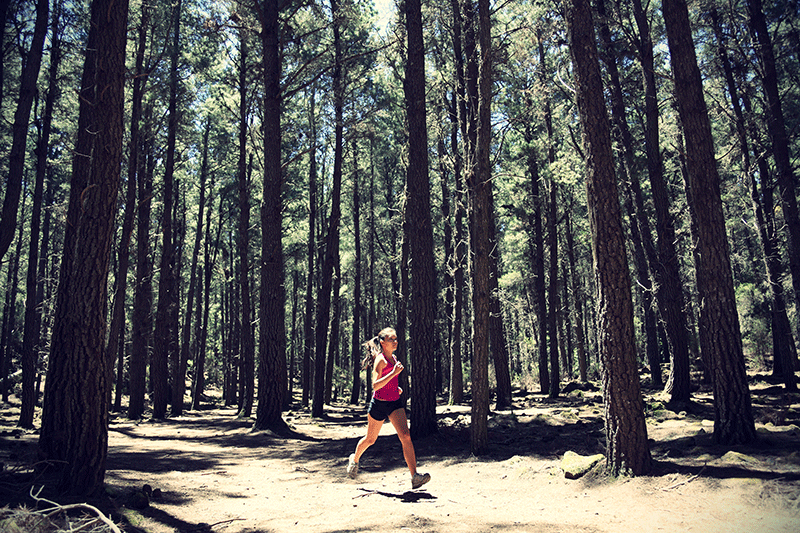Written by Dr. Daniel Shaye
—
Picture these scenes.
Mailbox. Curb. Car. Motorcycle.
Tree. Stream. Deer. Rabbit.
Which more appeals to you?
Running and walking can be enjoyable on a variety of surfaces. For me, trails are special. They’re kind to my soles—and my soul. Here are some considerations for those thinking of venturing off paved surfaces and onto soft-surface, multi-use trails, fields and greenways.
Enjoy the surface.
Running on roads or concrete can be brutal on the legs—not to mention feet, knees, hips and spine. Softer surfaces are kinder, less jarring and more forgiving. You can try to absorb shock with your shoes, but why not let the surface itself do some of the work?
Explore a different running form.
Roads, tracks and treadmills offer relatively predictable and uniform surfaces. Not so, the trail. A trail may be slick, or rocky, or covered in roots, or rutty, or banked at odd angles; or you may have to hurdle a placid toad. Trail running may require a shorter, more frequent stride that allows for sudden shifts in momentum and direction. Trail running form requires a lightness of stride, allowing you to quickly unweight a leg in favor of better footing. This builds a nimbleness that you may not normally explore or develop on more predictable surfaces.
Work on your hurdle form.
If you’re anything like me, you’re not going to wow anyone with your flexibility, so Olympic-class hurdling of fallen trees is out of the question. But what do you do when there’s a tree across the path? Leaping over it in full stride is one option, but only do so if you’re sure of your footing on the other side. Some will use the steeplechase hurdling style: touching the lead foot atop the tree or obstacle and propelling over. But beware slippery or mossy trees. If you do use the steeplechase style, tread lightly atop the tree and be prepared to adapt should that foot slip.
Run for the hills.
Cross-country and trail running—especially hilly trail running—are very effective ways to build power. Not all trails are hilly, but there’s a unique training value to running on a trail that not only heads uphill, but also has roots. Dancing over roots will take away some momentum, even as the hill challenges you aerobically. This requires intense focus and builds leg and ankle stability, coordination and aerobic power.
If the shoe fits.
If the trail might be slippery, you might want to try shoes that have a little extra traction. Trail running shoes tend to offer protection against objects such as rocks and roots. You’ll quickly discover that a trail is not a fancy outdoor treadmill. Trail running shoes typically cost about the same as a good road-training shoe—or even less.
Injury risks.
Trails are a joy, but they also present unique risks. The number one risk on the trail is to your ankles. A rock, root or rut can quickly cause what’s known as an inversion sprain, which can be as minimal as a brief moment of pain, or as serious as a fractured foot or ankle. Remain focused, and consider avoiding the trails in the Fall when they tend to be covered in obstacle-concealing leaves. Also, don’t launch into complicated trails before you’re ready. If you’re a trail novice, begin on a nice, wide, root-and-rock-free trail, and ease into the experience before trying rooty, rockier trails requiring nimble-footed hops and changes of direction.
Personal safety.
If you’re running alone in the woods, you need to be aware of your surroundings. Though two-legged predators are rare, earbuds are a bad idea. Next, be aware that if you injure yourself, you can’t count on having a car or pedestrian come by in the next few minutes—which can be a problem if it’s dangerously hot or cold. Also, beware of “sticks” that suddenly move. Though snake bites are rare (I’ve run 50,000 miles without getting bitten), Virginia does boast three poisonous varieties: copperhead, cottonmouth (water moccasin) and rattler. For the evening/night runner, recognize that most trails are sparsely lit, often shielded even from moonlight. Finally, do a “tick check” after a run in the woods or in high grass. Be thorough, as Lyme disease and other illnesses can have serious long-term consequences.
Visit another world.
Running can be about weight-loss, or about a merciless goal set by a watch. It can also be about joy, nature, exploration, freedom, beauty and poetry. I find that on the trail, it’s easy to find peace—an escape from the concrete jungle and all of life’s troubles. A fox, a turkey, a few quick steps, a blooming tree—and you’re free.

